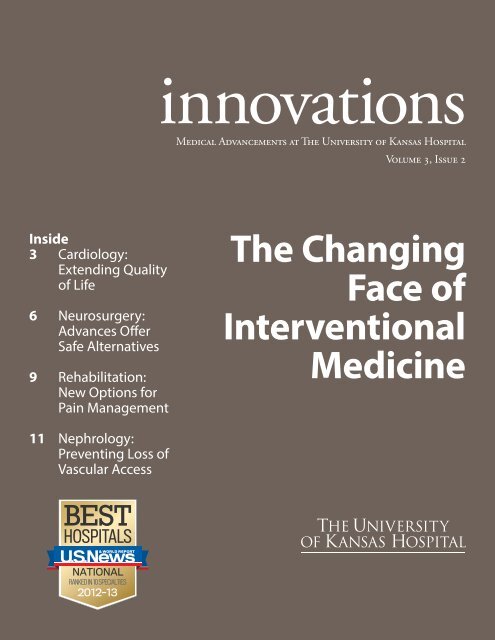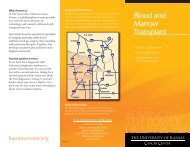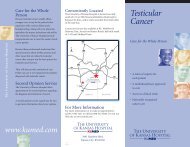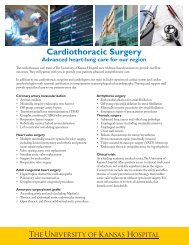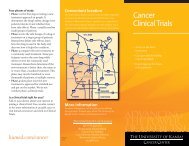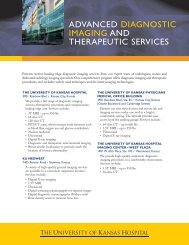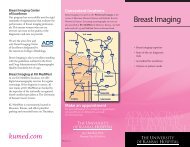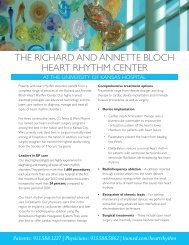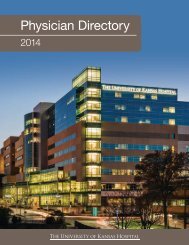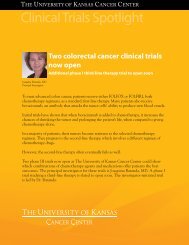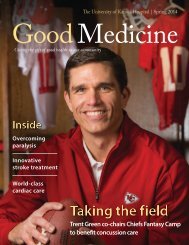The Changing Face of Interventional Medicine - The University Of ...
The Changing Face of Interventional Medicine - The University Of ...
The Changing Face of Interventional Medicine - The University Of ...
You also want an ePaper? Increase the reach of your titles
YUMPU automatically turns print PDFs into web optimized ePapers that Google loves.
innovationsMedical Advancements at <strong>The</strong> <strong>University</strong> <strong>of</strong> Kansas HospitalVolume 3, Issue 2Inside3 Cardiology:Extending Quality<strong>of</strong> Life6 Neurosurgery:Advances <strong>Of</strong>ferSafe Alternatives9 Rehabilitation:New Options forPain Management<strong>The</strong> <strong>Changing</strong><strong>Face</strong> <strong>of</strong><strong>Interventional</strong><strong>Medicine</strong>11 Nephrology:Preventing Loss <strong>of</strong>Vascular AccessKUMedInnovationsSummer2013_X.indd 16/13/13 10:09 AM
Medical Advancements at<strong>The</strong> <strong>University</strong> <strong>of</strong> Kansas Hospital3Minimally Invasive CardiovascularProcedures: New Options ExtendQuality <strong>of</strong> LifePeter Tadros, MDMedical Director, Heart Valve CenterTrip Zorn, MDSurgical Director, Heart Valve Center<strong>Interventional</strong> cardiology,electrophysiology andcardiothoracic surgery<strong>of</strong>fer new alternatives forpatients who otherwise face diminishedquality <strong>of</strong> life.<strong>The</strong>se innovations rely on fresh waysto use established technologies and anunprecedented level <strong>of</strong> cooperationamong medical and surgical disciplines.At <strong>The</strong> <strong>University</strong> <strong>of</strong> Kansas Hospital’sCenter for Advanced Heart Care, we<strong>of</strong>fer interventional procedures andaccess to clinical trials, including• Bioabsorbable cardiac stenting• Minimally invasive valve repair andreplacement• New treatment options forhypertrophic cardiomyopathy• Surgical treatment <strong>of</strong> atrialfibrillation• Other new applications <strong>of</strong>interventional cardiologytechniquesNew generation <strong>of</strong>absorbable stentsOne <strong>of</strong> the first truly new advancementsin the treatment <strong>of</strong> coronary arterydisease in years is the new bioabsorbablestent. Like a traditional stent, it aids inrestoring blood flow to the heart. Buta traditional metallic stent can affectvasomotion. In addition, traditionalmetallic stents increase risk <strong>of</strong> stentthrombosis and restenosis.By contrast, the bioabsorbable stentprovides excellent scaffolding and drugdelivery for six months and then beginsto be absorbed. <strong>The</strong> stent is completelyabsorbed in two years. Early studiesshow that vasomotion returns to normalafter absorption, as well. Eventually, thenew stent may lower the risk <strong>of</strong> stentthrombosis and reduce the need forprolonged dual antiplatelet drugs.<strong>The</strong> Absorb Bioresorbable VascularScaffold stent is nearly ready forrandomized clinical trials, and<strong>The</strong> <strong>University</strong> <strong>of</strong> Kansas Hospitalis the only hospital in the regionto participate.Catheter-based valve repair andreplacement therapyAbout 60,000 valve replacements areperformed in the United States everyyear. And as many as 400,000 peoplewith valve disease go without treatmentdue to their surgical risks. Transcathetervalve replacement therapy <strong>of</strong>fers anew option, especially for those whohave high surgical risk for morbidityto mortality. <strong>The</strong> <strong>University</strong> <strong>of</strong> KansasHospital is one <strong>of</strong> the only hospitalsin the nation, and the only one in theregion, to <strong>of</strong>fer all three transcatheteroptions, two for aortic and one forpulmonic valve replacement, currentlyavailable.Aortic valve replacement<strong>The</strong> Center for Advanced Heart Careis one <strong>of</strong> only a few <strong>of</strong>fering transaorticvalve replacement or implantationSURTAVI trialEarlier CoreValve® trials involved patients who were at high risk for surgery,mostly due to age. It simply assessed the safety and efficacy <strong>of</strong> the procedure.<strong>The</strong> <strong>University</strong> <strong>of</strong> Kansas Hospital is participating in the CoreValve SURTAVI trial,designed to evaluate the safety and efficacy <strong>of</strong> CoreValve in the treatment <strong>of</strong>symptomatic severe aortic stenosis in subjects who are at intermediate risk foraortic valve surgery. It is a randomized trial comparing TAVI with surgery.KUMedInnovationsSummer2013_X.indd 36/13/13 10:09 AM
Medical Advancements at<strong>The</strong> <strong>University</strong> <strong>of</strong> Kansas Hospitaltechniques have shown promise, theyare <strong>of</strong>ten lengthy, require retreatmentand include complications. Surgery– primarily the maze procedure – hasgreat potential, but many physiciansare reluctant to take this step when thecondition is medically manageable.Hybrid ablation and structuralcorrection are two new approachesthat show great promise.Structural: Amplatzer cardiacplug and LARIAT® deviceMore than 90 percent <strong>of</strong> clots thatcause strokes in patients with nonvalvular atrial fibrillation arise inthe left atrial appendage, or LAA, aubiquitous embryologic remnant.Blood thinners are the mainstay<strong>of</strong> therapy for stroke prophylaxis.However, a significant portion <strong>of</strong>patients who might benefit from bloodthinners have contraindications dueto systemic bleeding, frequent fallsand other potential problems. Somepatients without contraindications mayexperience stroke despite the use <strong>of</strong>blood thinners. Patients need treatmentstrategies that can potentially eliminatethe LAA from systemic circulation. <strong>The</strong>Amplatzer Cardiac Plug, or ACP, andthe LARIAT are devices used to occludethe LAA.<strong>The</strong> <strong>University</strong> <strong>of</strong> Kansas Hospital isone <strong>of</strong> 70 sites participating in a clinicaltrial for stroke prevention with the ACP,and the only location in the region.This is a two-to-one randomized trial <strong>of</strong>the ACP vs. anticoagulation studyingoverall success, safety and efficacy. Itinvolves inserting a catheter through thefemoral vein, performing a transseptalpuncture and placing the device withinthe LAA. This seals <strong>of</strong>f the LAA toblood flow and prevents clot formation.Scar tissue then forms to permanentlyseal <strong>of</strong>f the LAA where most AF-relatedembolic strokes originate.<strong>The</strong> LARIAT suture delivery deviceis a catheter-based system that uses asnare to close <strong>of</strong>f the LAA. It has beenshown to safely and reliably suture theLAA shut using combined endocardialand epicardial access. Like the ACP, theLARIAT involves inserting a catheterthrough the femoral vein, performinga transseptal puncture and placinga wire with a magnetic tip into theLAA. A catheter is also placed into thepericardium and another magnet-tippedwire is then placed through the catheteron the outside <strong>of</strong> the heart. <strong>The</strong> magnetsfind each other. A lasso or LARIAT isthen placed over the wire ensnaringthe LAA. An embedded suture then iscinched down over the LAA, closingit <strong>of</strong>f.In both <strong>of</strong> these procedures, the aim isto prevent strokes, and eliminate theneed for long-term anticoagulant drugsin patients with atrial fibrillation.Hybrid ablationFor patients with persistent orlongstanding AF, ablation therapydoesn’t yield similar results as itdoes in those with paroxysmal AF.A new hybrid technique, combininga percutaneous electrophysiologicalapproach with a mini-maze procedureholds great potential for bringing thebest <strong>of</strong> all these treatments together.With this approach, the surgeonperforms anatomically guided epicardialablation using continuous lines andcreates a left atrial box lesion throughminimally invasive right chest access.<strong>The</strong> electrophysiologist employselectrically guided mapping to performendocardial ablation, to identify gaps inthe epicardial ablation lesion sets and toabate triggers and re-entry arrhythmias.<strong>The</strong> benefits <strong>of</strong> hybrid ablation include• Shorter time for each procedure• Complete lesion set: epicardial +endocardial• Epicardial occlusion <strong>of</strong> LAA, if desired• Fewer complications• Improved outcomesThis approach is currently under studyfor a clinical trial later this year.To consult with a physician at theCenter for Advanced Heart Care,call 913-588-5862 or toll free877-588-5862. Find moreinformation at kumed.com/heart.Dr. Tadros is director <strong>of</strong> interventional services and Lynn H. Kindred, MD, Cardiovascular Catheterization Laboratories at<strong>The</strong> <strong>University</strong> <strong>of</strong> Kansas Hospital’s Center for Advanced Heart Care, a member <strong>of</strong> the Cardiovascular Research Institute andassistant pr<strong>of</strong>essor at the <strong>University</strong> <strong>of</strong> Kansas Medical Center.5Dr. Zorn is the surgical director <strong>of</strong> <strong>The</strong> <strong>University</strong> <strong>of</strong> Kansas Hospital’s Center for Advanced Heart Care Valve Center. Recentresearch includes “Role <strong>of</strong> hybrid endovascular suite in improving outcomes <strong>of</strong> surgical ligation <strong>of</strong> coronary artery fistula.” Steffen,Kelly; Zorn III, George Trip; Tadros, Peter; Gupta, Kamal. <strong>The</strong> Journal <strong>of</strong> Invasive Cardiology 2012, 24(1), E10-12.KUMedInnovationsSummer2013_X.indd 56/13/13 10:09 AM
<strong>Interventional</strong> Neurosurgery:Advances <strong>Of</strong>fer Safe AlternativesPaul Camarata, MD, Chair, NeurosurgeryKoji Ebersole, MD, Director, Endovascular NeurosurgeryDouglas Girod, MD, OtolaryngologyinnovationsRecent advancesin technology andprocedures forusing catheterbasedand other interventional methods inneurosurgery are providing faster, safer, moreeffective treatments. We now have moreoptions for treating certain aneurysms, strokesand other head and neck issues that may havebeen untreatable in the past. <strong>The</strong> best news,however, is that we have only just begun.<strong>The</strong> most common interventionalaneurysm repair attempts to “pack” theaneurysm, causing thrombosis that willreduce the pressure and inhibit rupture.<strong>The</strong> primary method is coiling: platinumwires delivered via catheter to fill theaneurysm as tightly as possible, leadingto clot formation and occlusion.This much less invasive technique workedbest initially on spherical aneurysms withsmall necks. Over time, we found betterways to fit the coils more tightly into oddlyshaped aneurysms and to more effectivelybridge the neck. We also have seen thedevelopment <strong>of</strong> balloons that inflatetemporarily in the vessel, giving us moretime to make the coils fit complex shapes.And new coiling materials and liquids areable to increase the density <strong>of</strong> the packing.Still, the recurrence rate with coiling canaverage around 15 percent.Each innovation in materials, proceduresand skill development holds the promise<strong>of</strong> even broader application, giving us hopefor continuing to dramatically increasethe survivability <strong>of</strong> these potentiallydevastating events. This is a review <strong>of</strong> some<strong>of</strong> the latest developments in:• Treatment <strong>of</strong> cerebral aneurysms• Mechanical thrombectomy• Other interventions in neurosurgeryand otolaryngologyEmbolization device virtually erasesevidence <strong>of</strong> aneurysmAbout 1 or 2 percent <strong>of</strong> the U.S.population likely has a cerebral aneurysm.That equates roughly to the entirepopulation <strong>of</strong> the state <strong>of</strong> Kansas orMissouri. Yet only a very small percentage– about 30,000 <strong>of</strong> these aneurysms – willrupture each year. Smaller aneurysms are<strong>of</strong>ten better left alone; depending on thepatient’s risk characteristics, they are notlikely to rupture. But larger, more complexaneurysms <strong>of</strong>ten warrant treatment.Open surgical treatment <strong>of</strong> aneurysm,most recently using surgical clips, has beenavailable for more than 60 years and hasproven very successful, with low recurrencerates. But interventional procedures havesurpassed open surgery by two or threeto one over the past 25 years, due to theirattractive minimally invasive nature.<strong>The</strong> new Pipeline embolization devicerelies on a completely different thoughtprocess. Instead <strong>of</strong> packing the aneurysmand allowing the blood flow to continuestressing that spot with each pulsation,the Pipeline relies on diverting blood flowaway from the weakened vessel wall.Unlike the usual stent, which is designed tobe as light as possible, the Pipeline is like adense hose, consisting <strong>of</strong> 48 braided wiresmade <strong>of</strong> 75 percent cobalt chromium and25 percent platinum tungsten. It is placedinside the vessel from which the aneurysmarises, providing supportive scaffoldingacross the aneurysm neck and keepingthe blood flow in a favored vector down6KUMedInnovationsSummer2013_X.indd 66/13/13 10:09 AM
innovationsIt is important to understand that theindications for clot retrieval are evolving. Inthe past, we sought this option only withinthe first three hours <strong>of</strong> stroke occurrence.But, in certain circumstances, that timewindow may be extended to six hours andeven beyond. Mechanical clot retrieval isthought to be most beneficial when thecore ischemic zone – where damage ispermanent – is small, and the ischemicpenumbra – where the tissue is stillpotentially viable – is relatively large. <strong>The</strong>sepatients may benefit from reperfusionthrough clot retrieval beyond the previousabsolute time marks.<strong>The</strong> bottom line, as with cerebralaneurysms, is to <strong>of</strong>fer stroke patients thegreatest number <strong>of</strong> options for treatment.As one <strong>of</strong> the first five healthcare facilitiesin the nation – and the only one inthe region – to be named an AdvancedComprehensive Stroke Center,<strong>The</strong> <strong>University</strong> <strong>of</strong> Kansas Hospital can<strong>of</strong>fer the greatest number and quality <strong>of</strong>treatment possibilities.Technology and experienceexpand use <strong>of</strong> other interventionaltechniques• New treatment for pseudotumorcerebriBroadened understanding <strong>of</strong>pathophysiology, coupled withLeading-edge research, extraordinary care<strong>The</strong> <strong>University</strong> <strong>of</strong> Kansas Medical Center is one <strong>of</strong> 25 sites selected in 2011to participate in the Network for Excellence in Neuroscience Clinical Trials, orNeuroNEXT. This federally funded group <strong>of</strong> research institutions works tospeed the development <strong>of</strong> new treatments forneurological disorders.<strong>The</strong> <strong>University</strong> <strong>of</strong> Kansas Hospital and the <strong>University</strong><strong>of</strong> Kansas Medical Center reinforce one another withstrong clinical initiatives and well-funded, leading-edgeresearch. It’s an extraordinary level <strong>of</strong> care that hasreceived national attention. <strong>The</strong> hospital’s neurology andneurosurgery care ranked No. 22 in U.S. News & WorldReport’s 2012-13 Best Hospitals list.advances in neuroendovasculartechnology, has increased treatmentoptions for patients with this difficultdiagnosis. A subset <strong>of</strong> patients developpseudotumor as a consequence <strong>of</strong>stenosis in the intracranial venoussinus system. A growing body <strong>of</strong>evidence suggests that intracranialstenting in the region <strong>of</strong> stenosis canresult in normalization <strong>of</strong> venous sinuspressures. <strong>The</strong> subsequent clinicalimprovement in these select cases canbe very satisfactory for both patientsand clinicians alike.• Managing vascular lesionsGrowing expertise and improvedtechnology also are expandingour ability to embolize head andneck lesions via endovascular andpercutaneous routes. Innovationsin interventional sclerotherapy<strong>of</strong>fer additional options for benignlesions such as hemangiomas andlymphangiomas. <strong>The</strong> application <strong>of</strong>these adjuvant techniques improvessurgical safety, decreases blood lossand operating times, and renders rarethe necessity to prescribe gross totalresection for benign vascular headand neck lesions.To consult with a specialist at theCenter for Advanced Brain andNeurological Care, call 913-588-5862or toll free 877-588-5862.Find more information atkumed.com/neurosciences.Dr. Camarata serves as chair <strong>of</strong> neurosurgery at <strong>The</strong> <strong>University</strong> <strong>of</strong> Kansas Hospital and associate pr<strong>of</strong>essor at the <strong>University</strong> <strong>of</strong> KansasSchool <strong>of</strong> <strong>Medicine</strong>. Recent research includes, “Collateral damage: heat transfer as a possible mechanism <strong>of</strong> optic nerve injury duringneurosurgical intervention.” Shaw, My Le; Kelley, Brian; Camarata, Paul; Sokol, Jason A. Ophthalmic Plastic and Reconstructive Surgery2012-09, 28(5), 328-30.Dr. Ebersole is director <strong>of</strong> endovascular neurosurgery at <strong>The</strong> <strong>University</strong> <strong>of</strong> Kansas Hospital and assistant pr<strong>of</strong>essor at the <strong>University</strong> <strong>of</strong>Kansas School <strong>of</strong> <strong>Medicine</strong>. Recent research includes, “‘Successful’ coiling <strong>of</strong> a giant ophthalmic aneurysm resulting in blindness: casereport and critical review.” Ashour, R.; Johnson, J.; Ebersole, K.; Aziz-Sultan, MA., Neurosurgical Review, May 2013.Dr. Girod is executive vice chancellor <strong>of</strong> the <strong>University</strong> <strong>of</strong> Kansas Medical Center, interim executive dean <strong>of</strong> the <strong>University</strong> <strong>of</strong> KansasSchool <strong>of</strong> <strong>Medicine</strong>, pr<strong>of</strong>essor <strong>of</strong> otolaryngology/head and neck surgery and is an associate member <strong>of</strong> cancer biology at <strong>The</strong> <strong>University</strong><strong>of</strong> Kansas Cancer Center. Recent research includes, “Functional swallowing outcomes following transoral robotic surgery vs primarychemoradiotherapy in patients with advanced-stage oropharynx and supraglottis cancers.” More, Y.I.; Tsue, T.T.; Girod, D.A.; Harbison, J;Sykes, K.; Williams, C; Shnayder, Y. JAMA Otolaryngol Head Neck Surgery, 2013 Jan. 139(1):43-8.<strong>The</strong> <strong>University</strong> <strong>of</strong> Kansas Hospital’s interventional neurosciences team also includes Ernest Madarang, MD, neuroradiologist, Alan Reeves,MD, neuroradiologist, and Michael Abraham, MD, neurointensivist. <strong>The</strong>se specialists, and all members <strong>of</strong> our multidisciplinary team,work together to ensure the best possible outcomes for aneurysm and stroke patients.8KUMedInnovationsSummer2013_X.indd 86/13/13 10:09 AM
Medical Advancements at<strong>The</strong> <strong>University</strong> <strong>of</strong> Kansas Hospital<strong>Interventional</strong> Rehabilitation <strong>Medicine</strong>:<strong>The</strong> New <strong>Face</strong> <strong>of</strong> Pain ManagementRaj Mitra, MD, Chair, Rehabilitation <strong>Medicine</strong>9An accurate diagnosis, efficiencyand continuity <strong>of</strong> care – that’s whatinterventional pain managementbrings to the field <strong>of</strong> physicalmedicine and rehabilitation.Traditionally, physical medicineand rehabilitation enter into patientcare following a surgical procedure.<strong>Interventional</strong> rehabilitation medicinespecialists at <strong>The</strong> <strong>University</strong> <strong>of</strong> KansasHospital are evolving our approachto rehabilitation to benefit patientsacross the spectrum <strong>of</strong> disease. Indoing so, we have developed the largestinterventional rehabilitation programin the region. As we continue to growthis subspecialty, we are positionedto serve as a resource for the medicalcommunity and patients throughout theregion, especially those with complexhealth issues.Across the spectrum <strong>of</strong> disease<strong>Interventional</strong> rehabilitation medicineis helping a diverse patient population,from recreational athletes with sportsinjuries to cancer patients sufferingwith swallowing and chewing difficulty.Regardless <strong>of</strong> the health concern, theapproach is the same. By focusing oncollaboration, accurate diagnosis andreasonable, conservative care, we <strong>of</strong>fertreatment that helps patients findrelief or improved function throughminimally invasive options. It is anin-depth approach taking into accountphysical exams, imaging and labstudies. and multiple viewpoints fromspecialists to determine treatment.We use this approach not merely forthe sake <strong>of</strong> using an intervention, butalways to serve the patient and, whereappropriate, to break the cycle <strong>of</strong>recurring pain and future treatments.Interventions may include:• Medication management• Customized physical therapy fromtherapists specializing in spine care• Pain management injections• Interventions using fluoroscopy• Alternative medicines andtherapies, such as acupuncture,aquatic therapy, alternative painmanagement and transcutaneouselectrical nerve stimulation, orTENS.For example, adhesive capsulitis maybe treated surgically which includesrecuperation and rehabilitation.Alternatively, an interventional shoulderprotocol provides an effective option.A suprascapular nerve block is followedby an injection <strong>of</strong> an intra-articularsteroid and an injection <strong>of</strong> an anestheticagent with brisement normal salinevolume dilation. <strong>The</strong> shoulder is thenmanipulated to break adhesions.Patients quickly experience improvedshoulder abduction and flexion and asignificant improvement <strong>of</strong> motion.Comprehensive care<strong>The</strong> Marc A. Asher, MD,Comprehensive Spine Center providesa range <strong>of</strong> patient care and facilitiesunequaled in the region and rarely seenacross the nation. Here, specialists fromorthopedics, neurosurgery, physicalmedicine and rehabilitation, speech andphysical therapy and anesthesia worktogether under one ro<strong>of</strong> providing acomprehensive perspective on spinalcare. <strong>The</strong> <strong>University</strong> <strong>of</strong> Kansas Hospitalhas the only fellowship for spine andpain interventions in the region.From joint injections to cyst aspirationsto epidural injections to radi<strong>of</strong>requencyneurotomy, interventional rehabilitationspecialists rely upon a range <strong>of</strong> toolsto disrupt pain signals, improvemovement, and help patients avoid therisks <strong>of</strong> both surgery and medications.In our women’s health program,interventionalists from rehabilitation,radiology, neurology, orthopedics andanesthesia work together to restore<strong>Interventional</strong> case studyA female patient presented at<strong>The</strong> <strong>University</strong> <strong>of</strong> Kansas Hospitalsuffering chronic pelvic pain. Afteran MRI, the interventional teamdiscovered the veins in the pelviswere dilated and diagnosed pelviccongestive syndrome. Working withradiology, the team embolized theseveins and, for the first time in 12years, the patient is pain free, can sitand participate in physical therapythat was previously too painful.KUMedInnovationsSummer2013_X.indd 96/13/13 10:09 AM
innovations<strong>The</strong> Case for CollaborationPhilip Johnson, MD, Chair, RadiologyWhile interventional radiology <strong>of</strong>ten benefits patients with shorter recovery times, better outcomes andminimized risk, “less invasive” doesn’t always equate to “less risk.” Overlap <strong>of</strong> treatment options exists for manymedical conditions. Hence a collaborative and multidisciplinary approach is essential to determine the besttreatment for an individual patient, be it interventional, surgical or medical.With 25 radiologists, five body-interventionalists and four neuro-interventionalists, <strong>The</strong> <strong>University</strong> <strong>of</strong> KansasHospital has the leading IR department in the region with the largest volumes. Through this experience anda commitment to continual research, training and multidisciplinary collaboration, we provide the full gamut <strong>of</strong> treatment forpatients, including the newest treatments, <strong>of</strong>ten before anyone else in the region.Technological advances are best for the patient when they travel on the heels <strong>of</strong> collaborative care. That’s the advantage thatwe have at <strong>The</strong> <strong>University</strong> <strong>of</strong> Kansas Hospital.function and manage pain for pregnantwomen and those with chronic pelvic,spine, hip or shoulder pain including sportsinjuries. Surgery-free pain managementinvolves similar interventional innovationsand collaboration.• A local nerve block at the ganglionimpar can relieve coccyx, pelvic orperineal pain.• Nerve blocks can resolve chronic,neuropathic perineal pain fromvisceral or sympathetic pain syndrome.• Coccygeal injections provide anothertherapeutic approach for managingcoccydynia.Cancer rehabilitation<strong>The</strong> cancer rehabilitation program isthe only one <strong>of</strong> its kind in the region.We assist oncology patients who haveany type <strong>of</strong> cancer, at any stage <strong>of</strong> theirdisease, by working to restore functionusing the advanced technology, includinginterventions. <strong>The</strong> emphasis is onevaluating and treating neuromuscular,musculoskeletal and functionalcomplications that may result from cancerand cancer treatments, including acuteand chronic pain, fatigue, muscle spasms,neuropathy, myopathy, radiation fibrosis,dystonia and spasticity among others.A cancer rehabilitation and pain specialistmay help reduce swelling in a patientwith lymphedema, for example, byemploying a custom therapy program thatincludes medications, steroid or anestheticinjections, and radi<strong>of</strong>requency nervelesioning.Our treatment is always multimodal toprovide comprehensive treatment and mayincorporate a combination <strong>of</strong> physical,occupational, and/or lymphedema therapy,assistive devices, orthotics, prosthetics,medications, patient education and, whenneeded, joint and s<strong>of</strong>t tissue injections.Collaborating for better patient careAs an academic medical center,<strong>The</strong> <strong>University</strong> <strong>of</strong> Kansas Hospital takes amultidisciplinary approach to every aspect<strong>of</strong> patient care. We begin with an accuratediagnosis and follow with a collaborative,evidence-based approach to treatment.<strong>The</strong> role that interventional rehabilitationmedicine may play in a patient’s treatmentand care is routinely considered as part <strong>of</strong>this process. <strong>Interventional</strong> rehabilitationmedicine is a logical evolution along thecontinuum <strong>of</strong> care.To consult with one <strong>of</strong> ourrehabilitation or radiologyspecialists, call 913-588-5862 ortoll free 877-588-5862. Find moreinformation on rehabilitationmedicine and interventionalradiology at kumed.com.Dr. Mitra is a pr<strong>of</strong>essor and serves as chair <strong>of</strong> rehabilitation medicine at the <strong>University</strong> <strong>of</strong> Kansas School <strong>of</strong> <strong>Medicine</strong>. Recent researchincludes, “Adjuvant analgesics in cancer pain: a review.” Mitra Raj; Jones Stephanie. <strong>The</strong> American Journal <strong>of</strong> Hospice & Palliative Care 2012,29(1), 70-79.<strong>The</strong> <strong>University</strong> <strong>of</strong> Kansas Hospital’s interventional rehabilitation program is attracting leading physiatrists from across the nation. S. KamalFetouh, MD, heads our cancer pain management and rehabilitation program. Dr. Fetouh previously served at Memorial Sloan-KetteringCancer Center. Tiffany Williams, MD, medical director <strong>of</strong> the Marc A. Asher, MD, Comprehensive Spine Center, recently joined us fromJohns Hopkins <strong>University</strong>. Dr. Williams will be involved in clinical research examining minimally invasive lumbar decompression.10KUMedInnovationsSummer2013_X.indd 106/13/13 10:09 AM
Medical Advancements at<strong>The</strong> <strong>University</strong> <strong>of</strong> Kansas HospitalEffects <strong>of</strong> <strong>Interventional</strong> <strong>Medicine</strong>in NephrologyAlan Yu, MDDirector, Kidney InstituteMore than 871,000 people in theUnited States are being treated forend-stage renal disease, accordingto the National Institute <strong>of</strong>Diabetes and Digestive and KidneyDiseases. <strong>Of</strong> those patients, more than365,000 receive renal replacement throughhemodialysis.For these patients, vascular access isboth a lifeline and an Achilles heel.While arteriovenous fistulas andgrafts are vital for dialysis, they aresusceptible to stenosis, thrombosis andinfection. When these complicationsoccur, prompt treatment is critical to apatient’s survival.Hospital admissions for vascular accessinfection rose steadily nationwide until2005. Since that peak, admissions havefallen 24 percent. A portion <strong>of</strong> thisdecline may be attributed to the rise <strong>of</strong>interventional medicine in nephrology.<strong>Interventional</strong> procedures<strong>Interventional</strong> procedures can quicklyclear arteriovenous fistulas forhemodialysis without open surgery andprovide better patient outcomes. Suchprocedures include catheter placement,fistulograms, percutaneous balloonangioplasties, thrombectomies, venousmapping and kidney biopsies.At <strong>The</strong> <strong>University</strong> <strong>of</strong> Kansas Hospital,our nephrologists work alongsideinterventional radiologists, providingthem with key knowledge about dialysis,the potential complications <strong>of</strong> vascularaccess, and the effects <strong>of</strong> complicationson patients’ treatments and quality<strong>of</strong> life. Using minimally invasiveprocedures and this multidisciplinaryapproach, we can quickly treat clots orfailures <strong>of</strong> arteriovenous fistulas andgrafts, renal artery stenosis, and many,ifif not all, vascular access complications.Improved care leads to loweroverall costsFor patients, the power <strong>of</strong> interventionalnephrology is realized in the reduction<strong>of</strong> emergency treatments andhospitalizations. Studies have showninterventional nephrology programsdecrease the number <strong>of</strong> hospitalizationsand missed dialysis treatments.However, beyond interventionalnephrology’s positive effect on patientcare, there is an undeniable financialimpact.In 2010, Medicare expendituressurpassed $30 billion with totalend-stage renal disease, or ESRD,expenditures amounting to $47.5billion. A significant proportion <strong>of</strong>these costs were due to complications <strong>of</strong>vascular access, emergency dialysis andhospitalizations <strong>of</strong> patients with ESRD.World-class kidney careFor the past four years, <strong>The</strong> <strong>University</strong><strong>of</strong> Kansas Hospital’s nephrologyprogram has ranked among the nation’sbest in U.S. News & World Report’s BestHospitals. Nephrology ranked No. 15among the nation’s top 50 for 2012-13. We <strong>of</strong>fer superb clinical fellowshiptraining, a widely respected clinicalprogram and a strong tradition intranslational medicine that integratesscientific research with clinical trials.To consult with one <strong>of</strong> ournephrologists, call 913-588-5862or toll free 877-588-5862. Findmore information at kumed.com.Dr. Yu is director <strong>of</strong> the division <strong>of</strong> nephrology and hypertension, and pr<strong>of</strong>essor <strong>of</strong> medicine at the <strong>University</strong> <strong>of</strong> Kansas School <strong>of</strong><strong>Medicine</strong>. He is also director <strong>of</strong> the Kidney Institute at the <strong>University</strong> <strong>of</strong> Kansas Medical Center. Dr. Yu is also co-editor <strong>of</strong>Brenner and Rector’s <strong>The</strong> Kidney, the internationally best-selling nephrology reference text.11KUMedInnovationsSummer2013_X.indd 116/13/13 10:09 AM
innovationsClinical trial aimed at advanced gastricor gastroesophageal junction cancerPeter J. Van Veldhuizen, MDPrincipal InvestigatorA Phase II Study <strong>of</strong> MK-2206(NSC-749607) as Second Line<strong>The</strong>rapy for Advanced Gastric orGastroesophageal Junction CancerThis phase II clinical trial studies howwell MK-2206 works in treating patientswith advanced gastric or gastroesophagealjunction cancer. MK-2206 may stop thegrowth <strong>of</strong> tumor cells by blocking some <strong>of</strong>the enzymes needed for cell growth.Eligibility criteria• 18 years or older with histologicallyor cytologically confirmedadenocarcinoma <strong>of</strong> the stomach orgastroesophageal junction• Disease that has progressed after firstlineregimen or is recurrent within thepast six months after adjuvant therapy• Measurable disease by CT scans orMRI within the past 28 days• No known brain metastases• Zubrod performance status 0-1• ANC ≥ 1,500/mm3• Platelet count ≥ 100,000/mm3• Hemoglobin ≥ 9 g/dl• Bilirubin normal• AST and ALT ≤ 2.5 times upper limit<strong>of</strong> normal (ULN) (≤ 5.0 times ULNfor patients with liver metastases).• Serum creatinine ≤ ULN or creatinineclearance > 50 mL/min• INF ≤ 1.2 (unless taking therapeuticWarfarin)• Fasting blood sugar ≤ 150 mg/dL• Hemoglobin A1C < 7%For a complete list <strong>of</strong> criteria, visitclinicaltrials.gov and use identifierNCT01260701 HSC12615. As youevaluate your patients in daily practice,consider referring those who may becandidates for this study. Enrollment iscurrently under way.For more information or to consultwith one <strong>of</strong> our oncologists, call913-588-5862 or 877-588-5862 tollfree. Or visit kucancercenter.org/consult.To learn more about our cancer clinicaltrials, visit kucancercenter.org/clinicaltrials.Nationally recognized excellence12KUMedInnovationsSummer2013_X.indd 126/13/13 10:09 AM
Medical Advancements at<strong>The</strong> <strong>University</strong> <strong>of</strong> Kansas HospitalPROGRESS NOTESNEWS AND RESOURCES FROMTHE UNIVERSITY OF KANSAS HOSPITALNEW LEADER FOR MEDICAL CENTERDouglas A. Girod, MD,has been appointedexecutive vicechancellor for the<strong>University</strong> <strong>of</strong> KansasMedical Center.Dr. Girod, a surgeon, previouslyserved as chair <strong>of</strong> the Department<strong>of</strong> Otolaryngology-Head and NeckSurgery since 2002.Dr. Girod has been deeply involvedin strategic planning, qualityimprovement and other crucialinitiatives at <strong>The</strong> <strong>University</strong> <strong>of</strong>Kansas Hospital. His leadership wasinstrumental in the otolaryngologyprogram’s rankings among thenation’s best by U.S. News & WorldReport over the past four years.Dr. Girod earned his medical degreefrom the <strong>University</strong> <strong>of</strong> Californiaat San Francisco and completedhis residency and an NIH researchfellowship at the <strong>University</strong> <strong>of</strong>Washington in Seattle. Prior tojoining the <strong>University</strong> <strong>of</strong> KansasMedical Center faculty in 1994, heserved as vice chairman and researchdirector in the Department <strong>of</strong>Otolaryngology at the Naval MedicalCenter in Oakland, Calif.He has given nearly 50 invitedpresentations to national andinternational organizations, coeditedthe textbook Oral CavityReconstruction, written 11 bookchapters and published 57 articles inscholarly journals.LIVER TRANSPLANTMILESTONE REACHEDEarlier this year, <strong>The</strong> <strong>University</strong> <strong>of</strong>Kansas Hospital became first in thestate and the Kansas City metro areato perform 1,000 liver transplants.Timothy Schmitt, MD, and JamesonForster, MD, performed the historicmilestone surgery. Forster also performedthe hospital’s first transplantin 1990. <strong>The</strong> hospital’s liver transplantprogram is now among the top 25programs by volume nationally.Patient outcomes, as measured byone-year survival, have remainedgreater than the national averageover the same period, even with 250percent growth in the program overthe last five years.GROUNDBREAKINGFOR REHABILITATIONFACILITYConstruction is under way for<strong>The</strong> <strong>University</strong> <strong>of</strong> Kansas Hospital’snew state-<strong>of</strong>-the-art inpatient acuterehabilitation care facility. Opening inspring 2014, the new facility will <strong>of</strong>fer29 patient rooms and a wide range<strong>of</strong> amenities to help patients preparefor self-care at home. <strong>The</strong> buildingis located near the main hospital atRainbow Boulevard, just south <strong>of</strong>39th Avenue.COMPLEX SURGERY DESTINATION CENTERAt <strong>The</strong> <strong>University</strong> <strong>of</strong> Kansas Hospital, we specialize in managing the most complex surgical cases. Our state-<strong>of</strong>-the-artsurgical suites allow us to work in tandem with a variety <strong>of</strong> specialists to perform the most advanced procedures withoutmoving the patient. Our centers <strong>of</strong> excellence <strong>of</strong>fer a multidisciplinary approach to the evaluation and treatment <strong>of</strong>multiple conditions, including heart disease, cancer, trauma, neurosurgery, burns and wounds, and organ transplant.Here, highly experienced surgeons devote their practices to complicated procedures for such uncommon conditions aspancreatic cancer, advanced melanoma, esophageal and gastric cancer, endocrine surgery and more. Whenever possible,surgeons use leading-edge technologies, such as the robotic daVinci® Surgical System, to perform less invasive surgicalprocedures. Our hospital is one <strong>of</strong> the few in the region with established experience in robotic surgery for gastrointestinalprocedures.Our survival rates are among the top third <strong>of</strong> academic medical centers nationwide. To consult with one <strong>of</strong> our surgeons,call 913-588-5862 or toll free 877-588-5862. For more information, please visit kumed.com/consult.13KUMedInnovationsSummer2013_X.indd 136/13/13 10:09 AM
NEW PHYSICIANS<strong>The</strong>se dedicated physicians have recently joined the medical staff at <strong>The</strong> <strong>University</strong> <strong>of</strong> Kansas Hospital.David W. Anderson, MDOrthopedicsMedical School: Creighton<strong>University</strong>Internship: <strong>University</strong> <strong>of</strong> KansasMedical CenterFellowship: MassachusettsGeneral HospitalDonald Beahm, MDOtolaryngologyMedical School: <strong>University</strong> <strong>of</strong>KansasInternship: Louisiana State<strong>University</strong> Health ScienceCenter-New OrleansResidency: Louisiana State<strong>University</strong> Health ScienceCenter-New OrleansFellowship: Thomas Jefferson<strong>University</strong>-PhiladelphiaCertification: American Board <strong>of</strong>OtolaryngologyPeter DiPasco, MDSurgical OncologyMedical School: <strong>University</strong> <strong>of</strong>Missouri-Kansas CityResidency: <strong>University</strong> <strong>of</strong> KansasMedical CenterFellowships: Washington<strong>University</strong>-St. Louis and<strong>University</strong> <strong>of</strong> Miami-Miller School<strong>of</strong> <strong>Medicine</strong>Certification: American Board <strong>of</strong>SurgerySherin Fetouh, MDRehabilitation <strong>Medicine</strong>Medical School: St. Georges<strong>University</strong>-GrenadaResidency: Thomas Jefferson<strong>University</strong> HospitalFellowship: Memorial SloanKettering Cancer CenterCertification: American Board<strong>of</strong> Physical <strong>Medicine</strong> andRehabilitationWilliam Freund Jr., MDGeneral SurgeryMedical School: <strong>University</strong> <strong>of</strong>KansasInternship: <strong>University</strong> <strong>of</strong> KansasMedical CenterResidencies: <strong>University</strong> <strong>of</strong>Kansas Medical Center and VidantMedical Center-East Carolina<strong>University</strong>Fellowship: St. Luke’s Hospital-Kansas CityCertification: American Board<strong>of</strong> SurgeryJulie Holding, MDPlastic & Reconstructive SurgeryMedical School: <strong>University</strong> <strong>of</strong>Texas Medical Branch-GalvestonResidency: <strong>University</strong> <strong>of</strong> TexasMedical Branch-GalvestonFellowship: <strong>University</strong> <strong>of</strong>WashingtonColleen Hupp, DOVascular SurgeryMedical School: Kansas City<strong>University</strong> <strong>of</strong> <strong>Medicine</strong> andBiosciencesResidency: <strong>University</strong> <strong>of</strong> KansasMedical CenterFellowship: <strong>University</strong> <strong>of</strong>Missouri-ColumbiaMichael Rippee, MDNeurologyMedical School: <strong>University</strong> <strong>of</strong>Missouri-Kansas CityInternship: <strong>University</strong> <strong>of</strong> KansasMedical CenterResidency: <strong>University</strong> <strong>of</strong> KansasMedical CenterFellowship: <strong>University</strong> <strong>of</strong> KansasMedical CenterSPINE CENTER ADDS NEW LOCATION<strong>The</strong> <strong>University</strong> <strong>of</strong> Kansas Hospital’s Marc A. Asher, MD, Comprehensive Spine Center has opened a location in southern Johnson Countyat our Indian Creek Campus. Fellowship-trained physicians provide care in six specialties, <strong>of</strong>fering patients a full complement <strong>of</strong> spineevaluation and treatment services under one ro<strong>of</strong>. <strong>The</strong> program serves patients with back, joint or neck pain; sports, work-related or othermusculoskeletal inquiries; and spinal deformities or infections.14KUMedInnovationsSummer2013_X.indd 146/13/13 10:09 AM
3901 Rainbow Blvd.Kansas City, KS 66160CME PROGRAMS at <strong>The</strong> <strong>University</strong> <strong>of</strong> Kansas HospitalThroughout the year, we provide the latest medicalinformation on a variety <strong>of</strong> topics to physicians andother healthcare pr<strong>of</strong>essionals.Our CME-accredited programs focus on essentialareas <strong>of</strong> patient care, including the prevention,diagnosis and treatment for specific conditions.Specialty areas include• Cancer• Cardiology and cardiovascular surgery• Neonatal intensive care• Neuroscience• Orthopedics and sports medicine• Pediatrics• Solid organ transplant• SurgeryFor more information, contact physicianrelations at 913-945-5241.Our programs are <strong>of</strong>fered topr<strong>of</strong>essionals who directly care foror treat patients within each CMEevent’s specific area <strong>of</strong> focus.Our events are planned andimplemented in accordance withthe Essential Areas and Policies<strong>of</strong> the Accreditation Council forContinuing Medical Educationthrough the joint sponsorship<strong>of</strong> the <strong>University</strong> <strong>of</strong> KansasMedical Center <strong>Of</strong>fice <strong>of</strong>Continuing Education andPr<strong>of</strong>essional Development and ourhospital. For more information,visit continuinged.ku.edu/kumc.KUMedInnovationsSummer2013_X.indd 156/13/13 10:09 AM


